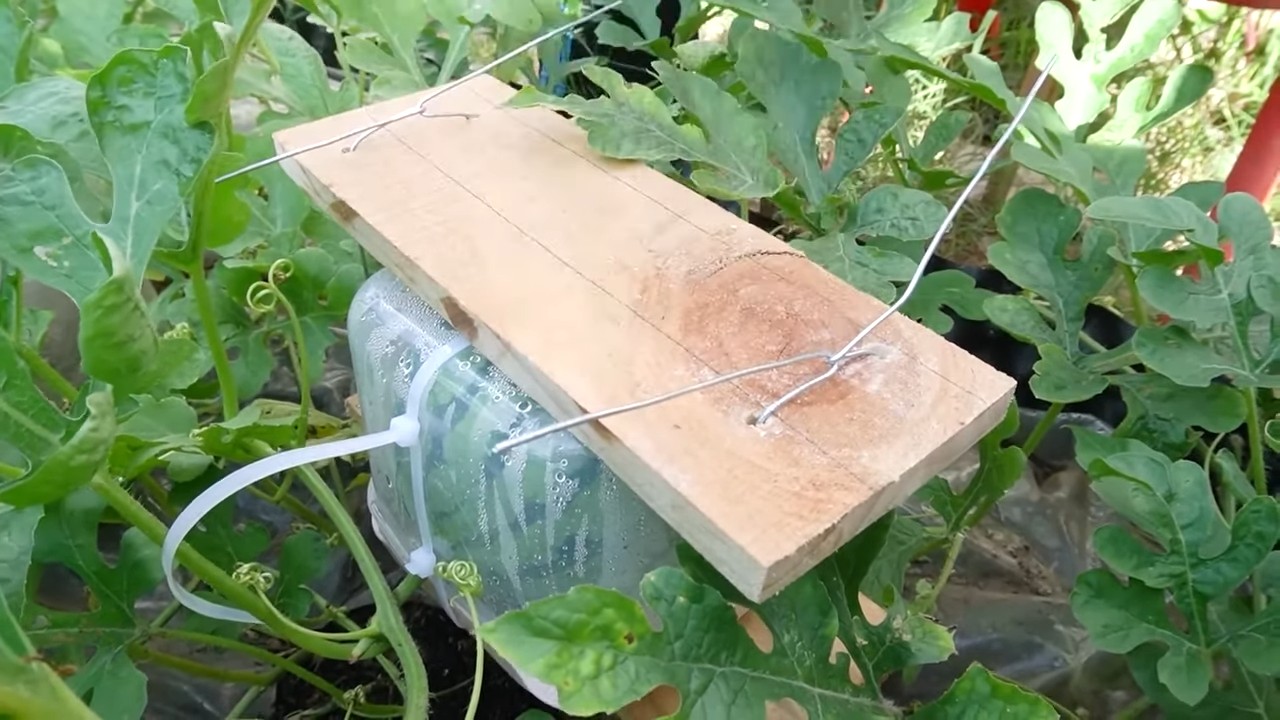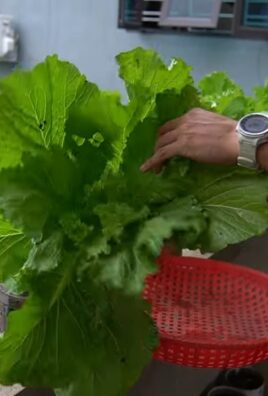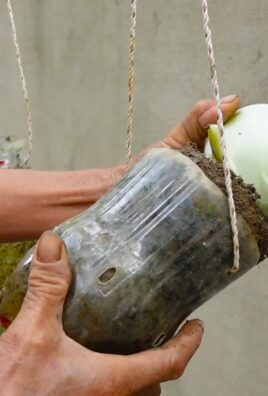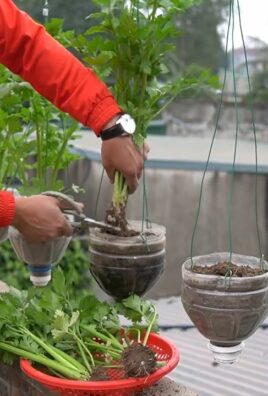Cucumber harvest hack: Are you tired of your cucumber plants producing a bounty all at once, leaving you scrambling to use them up before they turn yellow and bitter? Or perhaps you’re struggling to get a decent yield at all? I understand the frustration! There’s nothing quite like the satisfaction of growing your own crisp, refreshing cucumbers, but timing the harvest can be tricky.
For centuries, cucumbers have been cultivated across the globe, from their origins in India to their adoption in ancient Greece and Rome. They’ve been a staple in diets and even used for medicinal purposes. But even with all that history, mastering the cucumber harvest hack remains a challenge for many home gardeners.
That’s why I’m so excited to share this simple yet effective DIY trick that will revolutionize your cucumber harvest. This isn’t just about picking cucumbers; it’s about maximizing your yield, extending your harvest season, and ensuring you get the best-tasting cucumbers possible. Imagine enjoying fresh, perfectly ripe cucumbers throughout the summer, without the stress of a sudden glut or the disappointment of a meager harvest. This easy-to-implement hack will help you achieve just that! So, let’s dive in and unlock the secrets to a bountiful cucumber harvest!

Gurken-Ernte-Hack: So erntest du deine Gurken wie ein Profi!
Hallo liebe Gartenfreunde! Ich bin total begeistert, euch heute einen super praktischen Hack zu zeigen, der eure Gurkenernte revolutionieren wird. Schluss mit überreifen, bitteren Gurken und hallo zu einer kontinuierlichen, leckeren Ernte! Dieser Trick ist einfach, kostengünstig und spart euch jede Menge Zeit und Frust. Lasst uns loslegen!
Was du brauchst:
* Eine scharfe Gartenschere oder ein Messer
* Einen Eimer oder Korb für die geernteten Gurken
* Geduld und ein wachsames Auge!
Die Grundlagen der Gurkenernte: Wann ist der richtige Zeitpunkt?
Bevor wir uns dem eigentlichen Hack widmen, ist es wichtig zu verstehen, wann der optimale Zeitpunkt für die Gurkenernte ist. Eine zu frühe Ernte bedeutet, dass die Gurken nicht ihr volles Aroma entwickelt haben, während eine zu späte Ernte zu bitteren und überreifen Früchten führt. Hier sind einige Anzeichen, auf die du achten solltest:
* Größe: Die Größe der Gurke hängt natürlich von der Sorte ab. Informiere dich, welche Größe für deine Gurkensorte ideal ist. In der Regel sind Salatgurken erntereif, wenn sie etwa 20-25 cm lang sind, während Einlegegurken deutlich kleiner geerntet werden.
* Farbe: Die Gurke sollte eine gleichmäßige, kräftige grüne Farbe haben. Gelbliche oder bräunliche Stellen deuten auf Überreife hin.
* Festigkeit: Die Gurke sollte sich fest anfühlen, wenn du sie leicht drückst. Wenn sie weich oder schwammig ist, ist sie wahrscheinlich überreif.
* Dornen: Einige Gurkensorten haben kleine Dornen auf der Oberfläche. Wenn diese leicht abfallen, ist das ein Zeichen für Reife.
Der Gurken-Ernte-Hack: So geht’s!
Dieser Hack zielt darauf ab, die Gurkenpflanze so wenig wie möglich zu stressen und gleichzeitig eine saubere und effiziente Ernte zu gewährleisten.
Schritt 1: Die richtige Ausrüstung
Wie bereits erwähnt, benötigst du eine scharfe Gartenschere oder ein Messer. Eine stumpfe Schere kann die Pflanze beschädigen und das Wachstum neuer Gurken beeinträchtigen. Stelle sicher, dass deine Schere sauber ist, um die Ausbreitung von Krankheiten zu verhindern. Ich persönlich bevorzuge eine kleine, handliche Gartenschere, da sie präziser ist.
Schritt 2: Die Suche nach reifen Gurken
Gehe deine Gurkenpflanzen sorgfältig durch und suche nach Gurken, die die oben genannten Kriterien erfüllen. Achte darauf, auch unter den Blättern zu suchen, da sich dort oft reife Gurken verstecken. Es ist wichtig, regelmäßig zu ernten, da dies die Pflanze dazu anregt, weiterhin neue Früchte zu produzieren.
Schritt 3: Der Schnitt
Hier kommt der eigentliche Hack! Anstatt die Gurke einfach abzureißen oder zu verdrehen, schneidest du sie mit der Gartenschere oder dem Messer ab.
* Suche den Stiel: Finde den Stiel, der die Gurke mit der Pflanze verbindet.
* Der richtige Winkel: Schneide den Stiel etwa 1-2 cm oberhalb der Gurke ab. Achte darauf, den Stiel nicht zu quetschen oder zu zerreißen.
* Sauberer Schnitt: Mache einen sauberen, geraden Schnitt. Ein sauberer Schnitt minimiert das Risiko von Krankheiten und Schädlingen.
Warum ist dieser Schnitt so wichtig?
Das Abschneiden der Gurke anstatt des Abreißens hat mehrere Vorteile:
* Weniger Stress für die Pflanze: Das Abreißen kann die Pflanze beschädigen und das Wachstum neuer Gurken beeinträchtigen.
* Verhindert Krankheiten: Ein sauberer Schnitt minimiert das Risiko von Pilzinfektionen und anderen Krankheiten.
* Längere Haltbarkeit: Gurken, die abgeschnitten wurden, halten in der Regel länger als abgerissene Gurken.
Schritt 4: Die Ernte
Lege die geernteten Gurken vorsichtig in deinen Eimer oder Korb. Vermeide es, sie zu werfen oder zu stapeln, da dies zu Druckstellen führen kann.
Schritt 5: Regelmäßige Kontrolle
Überprüfe deine Gurkenpflanzen regelmäßig, idealerweise alle ein bis zwei Tage, um reife Gurken zu ernten. Je öfter du erntest, desto mehr Gurken wird deine Pflanze produzieren.
Zusätzliche Tipps für eine erfolgreiche Gurkenernte:
* Bewässerung: Gurken benötigen viel Wasser, besonders während der Fruchtbildung. Achte darauf, dass der Boden immer feucht ist, aber nicht durchnässt.
* Düngung: Dünge deine Gurkenpflanzen regelmäßig mit einem ausgewogenen Dünger.
* Schutz vor Schädlingen: Überprüfe deine Pflanzen regelmäßig auf Schädlinge wie Blattläuse oder Spinnmilben.
* Unterstützung: Gurkenpflanzen können sehr groß werden und benötigen möglicherweise eine Unterstützung, wie z.B. ein Rankgitter oder einen Zaun.
Häufige Fehler bei der Gurkenernte und wie man sie vermeidet:
* Zu frühe Ernte: Warte, bis die Gurken die richtige Größe und Farbe haben.
* Zu späte Ernte: Überreife Gurken sind bitter und weniger schmackhaft.
* Beschädigung der Pflanze: Sei vorsichtig beim Ernten, um die Pflanze nicht zu beschädigen.
* Vernachlässigung der Bewässerung und Düngung: Gurken benötigen viel Wasser und Nährstoffe, um optimal zu wachsen.
Was tun mit der Gurkenernte?
Nachdem du deine Gurken geerntet hast, gibt es unzählige Möglichkeiten, sie zu genießen! Hier sind einige Ideen:
* Frisch essen: Gurken sind ein erfrischender Snack für heiße Tage.
* Salat: Gurken sind eine beliebte Zutat in Salaten.
* Eingelegte Gurken: Eingelegte Gurken sind eine leckere Beilage zu vielen Gerichten.
* Gurkensuppe: Gurkensuppe ist eine erfrischende und gesunde Mahlzeit.
* Gurkenwasser: Gurkenwasser ist ein erfrischendes und hydratisierendes Getränk.
Fazit:
Mit diesem einfachen Gurken-Ernte-Hack kannst du deine Gurkenernte optimieren und sicherstellen, dass du immer frische, leckere Gurken zur Verfügung hast. Probiere es aus und lass mich wissen, wie es funktioniert hat! Viel Spaß beim Gärtnern!

Conclusion
So, there you have it! This simple, yet incredibly effective, cucumber harvest hack is more than just a gardening tip; it’s a game-changer for anyone looking to maximize their cucumber yield and minimize plant stress. We’ve walked you through the process, highlighting the benefits of using this gentle harvesting technique, and hopefully, dispelled any doubts you might have had about its effectiveness.
Why is this a must-try? Because it’s about more than just picking cucumbers. It’s about fostering a healthier, more productive plant. By avoiding the tugging and pulling that can damage delicate vines, you’re ensuring that your cucumber plant can continue to channel its energy into producing even more delicious, crisp cucumbers. Think of it as a small investment in the long-term health and productivity of your garden.
But the beauty of gardening lies in its adaptability. Feel free to experiment with variations on this technique. For instance, if you’re dealing with particularly thick cucumber stems, you might find that using a small, sharp pruning shear provides an even cleaner cut. Or, if you’re concerned about potential disease transmission, you can sanitize your cutting tool with rubbing alcohol between each cut.
Consider the type of cucumbers you’re growing. Some varieties have more delicate vines than others. For those, extra care is needed. You could even use a small, soft cloth to support the cucumber as you make the cut, preventing any accidental snapping or tearing.
Don’t limit yourself to just cucumbers! This gentle harvesting principle can be applied to other vining vegetables like zucchini, summer squash, and even some types of melons. The key is to minimize stress on the plant and ensure a clean, precise cut.
We understand that trying new things in the garden can sometimes feel daunting. But trust us, this cucumber harvest hack is so simple and straightforward that even beginner gardeners can master it with ease. And the rewards – a bountiful harvest of healthy, delicious cucumbers – are well worth the effort.
So, what are you waiting for? Head out to your garden, grab your preferred cutting tool, and give this cucumber harvest hack a try. We’re confident that you’ll be amazed at the difference it makes.
More importantly, we want to hear about your experience! Share your photos, tips, and stories with us in the comments section below. Let us know what worked well for you, what challenges you encountered, and any variations you discovered along the way. Together, we can learn and grow, creating a community of thriving gardeners. Happy harvesting!
Frequently Asked Questions (FAQ)
Q: What type of cutting tool is best for this cucumber harvest hack?
A: The ideal cutting tool is something sharp and clean. A small, sharp knife, pruning shears, or even a pair of kitchen scissors can work well. The most important thing is to ensure that the blade is clean to prevent the spread of disease. Many gardeners prefer pruning shears because they offer a clean, precise cut with minimal effort. If you’re using a knife, make sure it’s not serrated, as a serrated blade can tear the vine instead of cutting it cleanly. Remember to sanitize your tool regularly, especially if you’re harvesting from multiple plants.
Q: Will this harvesting method work for all types of cucumbers?
A: Yes, this harvesting method is generally suitable for all types of cucumbers, from slicing cucumbers to pickling cucumbers and even specialty varieties. However, the size and thickness of the cucumber stem may vary depending on the variety. For cucumbers with thicker stems, you might need to use a slightly larger or sturdier cutting tool. For cucumbers with very delicate vines, extra care should be taken to support the cucumber while making the cut.
Q: How often should I harvest my cucumbers?
A: The frequency of harvesting depends on the cucumber variety and growing conditions. Generally, cucumbers should be harvested when they reach their desired size and color, which is typically every few days. Overripe cucumbers can become bitter and less flavorful, and leaving them on the vine can signal to the plant to stop producing more fruit. Regular harvesting encourages continuous production throughout the growing season.
Q: What if I accidentally damage the vine while harvesting?
A: Accidents happen! If you accidentally damage the vine while harvesting, don’t panic. If it’s a minor tear, the plant will likely recover on its own. However, if the damage is significant, you can try to repair the vine by wrapping it with grafting tape or securing it with plant ties. Monitor the damaged area closely for signs of infection or disease. In some cases, it may be necessary to prune the damaged portion of the vine to prevent further problems.
Q: Can I use this method for other vegetables besides cucumbers?
A: Absolutely! The principle of gentle harvesting can be applied to other vining vegetables like zucchini, summer squash, and even some types of melons. The key is to minimize stress on the plant and ensure a clean, precise cut. For larger vegetables like melons, you might need to use a larger and sturdier cutting tool. Always be mindful of the plant’s structure and support the fruit as you make the cut to prevent any accidental damage.
Q: What are the benefits of using this cucumber harvest hack compared to just pulling the cucumbers off the vine?
A: Pulling cucumbers off the vine can cause significant stress and damage to the plant. This can lead to reduced yields, increased susceptibility to disease, and even plant death. The cucumber harvest hack, on the other hand, minimizes stress by allowing for a clean, precise cut. This helps to maintain the health and vigor of the plant, resulting in a more bountiful and prolonged harvest. Additionally, a clean cut reduces the risk of infection and disease, as it prevents open wounds on the vine.
Q: How do I know when a cucumber is ready to be harvested?
A: The best way to determine when a cucumber is ready to be harvested is to check the seed packet or plant tag for specific information about the variety you’re growing. Generally, cucumbers should be harvested when they reach their desired size and color, which is typically a deep green. The skin should be firm and smooth, and the cucumber should feel heavy for its size. Overripe cucumbers may turn yellow or develop a bitter taste.
Q: What should I do with my harvested cucumbers?
A: The possibilities are endless! Freshly harvested cucumbers can be enjoyed in salads, sandwiches, and other dishes. They can also be pickled, fermented, or used to make refreshing cucumber water. Store your harvested cucumbers in the refrigerator to keep them fresh for longer.
Q: Is there anything else I should consider when harvesting cucumbers?
A: Yes, there are a few other things to keep in mind. First, try to harvest your cucumbers in the morning, when they are at their coolest and freshest. Second, be gentle when handling the cucumbers to avoid bruising or damaging them. Third, inspect your plants regularly for signs of pests or diseases and take appropriate action if necessary. Finally, don’t be afraid to experiment with different harvesting techniques and find what works best for you and your garden.




Leave a Comment